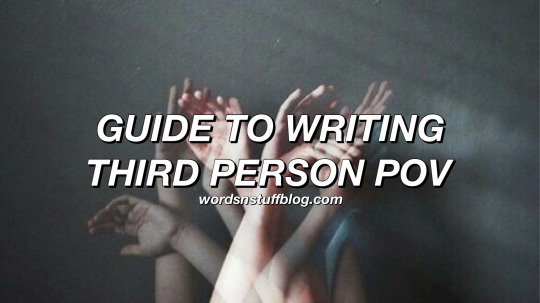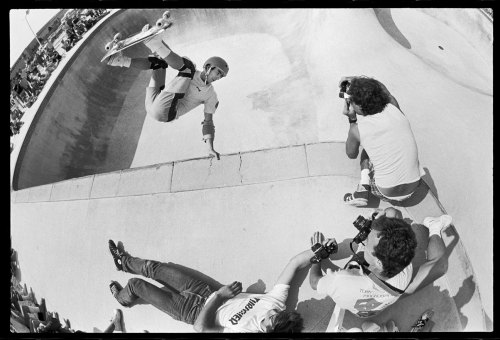#point of view
Some roleplays require you to write in third person deep point of view (different to third person POV). Here’s a few tips that’ll help you with this narrative voice! Please note that this wasn’t written by me, and credit goes here. [x]
So you know the rules of point of view (POV), the difference between first and third person. You understand what writers refer to as “deep POV.” You’ve decided you want to write that way, offering your reader an immersive experience in the thoughts and senses of your character. But when looking at your scenes, how do you know you’re writing deep? And if you’re not, how do you start?1) Eliminate sense verbs; instead, describe the sense itself. This is the difference between He saw a flower growing through the gaps in the fence and A flower grew through the gaps in the fence. In the first, the reader is seeing the character see something. In the second, the reader is seeing what the character sees. For the same reason, deep POV characters should never remark on their own blushing cheeks or white smile (unless they’re standing in front of a mirror). This principle can be applied to all of the senses, almost all the time. He heard an alarm blaring from the hallway vs. An alarm blared from the hallway. Tell us the coffee tasted too sweet, not that she tasted the coffee.

–
Depict, Don’t Report
The old adage of “show, don’t tell” is most applicable to third person narration, because it is here that writers most often make the mistake of reporting events in an especially monotonous fashion rather than illustrating them. Utilizing a variety of sentence structure, intentional vocabulary, and engaging pace/tone is the key to pulling your reader into the story rather than simply dictating a series of events. Third person point of view can make it difficult for a reader to connect intimately with the story, as the more objective voice or subtlety of the narrator’s bias can translate in a less personal manner than first person. It’s imperative to receive feedback on how well your use of alternative methods is drawing the reader into the story throughout.
Including Backstory & Context
Backstory is more convenient with third person POV, because you’re not limited to the knowledge of a single character. (Of course, this is assuming that you’re writing in third person omniscient, rather than limited. There will be a follow-up article all about limited POV in the near future, but for the purpose of this article, this focuses on omniscience.) You can utilize information, memories, and backstory of your entire cast or world, and furthermore give your reader insights into the characters’ actions or world building that they would not have in first person. Take advantage of this allowance to create a rich narrative with clear connections between characters, plot points, and information.
Developing Secondary Characters
The ability to further develop secondary characters is a major advantage of utilizing third person narration, because you are not so limited in the scope of information being revealed to the reader. You can shift the focus of the narrative to situations that solely involve characters other than your protagonist, and this offers the unique perspectives of characters outside or on the periphery of the main conflict. You can develop subplots more efficiently, offer the reader information your protagonist isn’t aware of to create suspense, and enrich your world outside of their limited perspective. This makes third person an optimal point of view to utilize when telling a particularly complex story or one that is set in a quite complicated world.
Distinctive Voice
When one is writing in the third person, it can be easy to fall into the habit of filling the pages with paragraphs of unnecessary description in order to achieve goals of length or in emulation of a particular writing style. This is often also the result of maintaining a needlessly objective narration. It is reasonable to write in the third person with a particular slant or bias. It gives the narrator their own voice, and makes the writing more engaging. Not just in the way of an unreliable narrator, where the bias in narration distorts or exaggerates the essence of the plot. You as the writer or narrator should have a voice that is just as distinctive as any character would have, although it’s generally agreed that a third person narration should be more subtle than a first person narration.
Practice & Adjustment
Third person point of view can be difficult to get accustomed to. It is a more impersonal style of writing. When writing about intimate or meaningful messages/events/characters, it can feel more natural to adhere to a first person perspective, even if third person better serves the story overall. It’s important that you actively practice if you’re unfamiliar with writing an entire story in third person. Getting used to approaching certain events or depicting certain emotions from a third person perspective is immeasurably helpful to the process of creating an engaging story. It can also help to practice thinking about events from that perspective if you’re prone to switching perspectives reflexively when you’re trying to articulate emotion or tone, which is a struggle I see often with new attempts at this POV.
Common Struggles
~ When dealing with multiple characters that have they/them pronouns, what’s a good way to keep the reader from getting mixed up? I assume that you would want to try and rely on a different sentence structure that allows you to clarify whom you’re referring to with context clues, rather than pronouns. It may seem less clear or accessible, but it’s very possible to write in a way where each sentence doesn’t start with “he said, she said, they said”. It’s also important that you master the way in which you write about each individual character. This will help your reader to correctly anticipate who you’re writing about and when.
~ When writing third person POV, how do you write multiple people’s emotions and perspectives at the same time? Focus on how they express their emotions rather than communicating exactly what they’re feeling and why. If the reader needs to comprehend the ins and outs of their thought process, perhaps third person isn’t suitable for the story.
~ And if lots of people with the same pronouns are in the same scene, what are useful ways to distinguish between the characters without using their names all the time? Clarify who you are referring to whenever “the camera moves”. When the focus shifts in space rather than subject, you must signal to the reader that this has happened. The use of dialogue tags is not an efficient way to do this, and many writers will often make the mistake of leaning too heavily on them. Instead, give your characters “stage business”, or an activity that they’re engaging with while dialogue is happening, and when they become the center of attention, refer back to the activity in a subtle way. Move the camera. Although, it is important to note that you rarely need so much dialogue in a scene to communicate information to the reader that you would get lost in the crowd of involved characters. Consider what you could better share through description and action, rather than dialogue.
~ How do you make sure you don’t use too many pronouns in a paragraph to refer to a certain character? Consider whether your descriptive style is too procedural. Natural writing flows without an abundance of clarifying pronouns, and if you start every sentence in a paragraph with “she did this, she saw that, she noticed, she heard, she felt” your writing will fall flat. Experiment with sentence structure, descriptive style, and perspective in your writing. At a certain point, your reader should be in a groove where they can keep up with who you’re referring to, even through context clues having to do with a large cast in the same scene.
~ How do I maintain momentum and clarity when writing in third person limited POV? For those who may not know, third person limitation is the narration of a single character’s perspective (at a time, if the story focuses on multiple characters). This point of view can be tricky because the limitation requires you to differentiate what each character knows and when they become aware of things that may already be known by other point of view characters.
The best advice I can give when attempting this is to be very diligent in keeping your characters’ stories and inner monologues straight. Keep track of who knows what, when they found (or will find) out, and refer to this timeline regularly as your story progresses. It’s also worth your time to strategize with your key pieces of information. If your reader has already learned this information through another character’s perspective, then reviewing this through the eyes of another must be illuminating in a different way, or the process of the other characters’ discoveries of what we already know must add to the suspense/emotional build/payoff. Pieces of information are the fireworks of your story, and you need to release or repeat them with great care for the greater show.
Other Resources
- Pros & Cons of Different Points of View
- Resources For Describing Characters
- Resources For Describing Emotion
- How To Fit Character Development Into Your Story
- Giving Characters Distinct Voices in Dialogue
- Conveying Emotions
- Tips on Introducing Characters
- Introducing Secondary Characters
- Tips on Character Consistency
- Resources For Plot Development
- Guide To Plot Development
- Tackling Subplots
- Character Driven vs. Plot Driven Stories
- Finding Your Own Writing Style
- How To Engage The Reader
- Tips on Introducing Backstory
- Describing Setting
- Resources For Worldbuilding
- Resources For Describing Physical Things
- Tips on Introducing Political Backstory
- Improving Your General Writing Skills|Part II
- How To Develop A Distinct Voice In Your Writing
- Tips On Dialogue
- Using Vocabulary
- Balancing Detail & Development
- Showing Vs Telling
- Writing In Third Person POV
- Improving Flow In Writing
- What To Cut Out of Your Story
- How To Perfect The Tone
- Tips on Balancing Development
–
If you enjoy my blog and wish for it to continue being updated frequently and for me to continue putting my energy toward answering your questions, please considerBuying Me A Coffee, or pledging your support on Patreon, where I offer early access and exclusive benefits for only $5/month.
There’s nothing more relaxing than reading along to the sound of crashing waves and the smell of salt water spray…
Post link
We all know how important Point of View is to the story. It’s one of the few things that must absolutely be decided before we put pen to paper. So I’d say it’s high time I give it some attention, no? Let’s talk.
(May contain spoilers for the following: D.J. MacHale’s Pendragon,Chuck Palahniuk’s Fight Club, F. Scott Fitzgerald’s The Great Gatsby)
First, Third Limited, Third Omniscient
Most of us are familiar with the basic Points of View, but let’s go over them.
First person is the limited point of view told from one character’s perspective. In this point of view, the character is the direct speaker. First person is a great POV to use when you want to get into the character’s head, to show the reader how the world looks from inside the character’s mind. For this example, we’ll use Chuck Palahniuk’s Fight Club. The story is told from the Narrator’s perspective. We get to see what the Narrator sees. This also means we get to see only what the Narrator sees. Anything that happens outside of the Narrator’s understanding or view is hidden from us. When writing first person, the main thing to remember is that you cannot reveal information that the speaker would not be aware of. You should also keep in mind that the character’s personality may color their understanding of a situation or affect their reliability. This can also be used to your advantage. Ever wondered how to tell a single POV story and hide information from your reader? This is one way that you can do that.
Third person limited is a limited point of view told from one character’s perspective, but that character is not the direct speaker. Rather the story is told as if looking over the character’s shoulder. Like first person, we see only what the character sees, but the story is told as if someone else is speaking about the character. For this example, let’s use D.J. MacHale’s Pendragon series. The portions of the story in Mark’s point of view are told in third person limited. Although we see various other characters within these parts of the book, most notably Courtney, we are being told the story from Mark’s perspective and only see events that happen in his presence. Third person limited has the same things to watch out for as first person. However, third limited gives you just a little more leg room to speak objectively than in first person.
Third person omniscient is the most freeing of the three basic POVs. Third person omniscient is, at its simplest, the all-knowing point of view. Typically, third person omniscient is the telling of the story from multiple character’s POVs. Whereas limited is like looking of the shoulder of a character, omniscient is like having a bird’s-eye view of the story. I’ll use two examples for this one: George R.R. Martin’s A Song of Ice and Fire and Jane Austen’s Pride and Prejudice. In ASOIF, Martin tells the story using the POVs of many different characters. We get a widespread view of the plot by getting to look through the eyes of many. In Pride and Prejudice, although the story centers mainly around Elizabeth, Austen writes from an all-knowing perspective, telling us some information that Elizabeth would not necessarily know. Third omniscient allows you to reveal or keep hidden events as you see fit. It gives you the ability to explore other sides of the plot. Be careful, though. Jumping from POV to POV like in ASOIF can be tricky. You want to make sure that each character’s story is distinct. The reader should know which character they are reading about without having to check the beginning of the chapter or scour the pages for mention of a name.
Also, if we’re splitting hairs, ASOIF is what we can call third person limited-omniscient. It’s a nice little hybrid of the two types. Although the overall story is told from many different points of view, each chapter is seen from a limited perspective. The narrator, in the scope of a single chapter, does not appear all-knowing, unlike in Pride and Prejudice.
Using POV to Make the Story Unique
Now that we’ve reviewed the basic POVs, let’s talk about some examples in which the writers used POV to their advantage to make their stories unique.
People are always asking, did I know about Tyler Durden.
It’s no secret that I will use just about any excuse to talk about Chuck Palahniuk when discussing first person, but there’s a good reason for it. The masterful thing about Fight Club is the way Palahniuk used first person perspective to hide the most important plot point of the story - that the Narrator and Tyler Durden are the same person.
This is something that would have be hard, if not impossible, to accomplish in third person. For most people visiting Fight Club for the first time, that plot twist is one they don’t see coming. That’s because Palahniuk uses that limited POV to hide information that would otherwise reveal the punchline. Instead, we see everything the Narrator sees. We’re given all of the same hints that the Narrator is given. The Narrator doesn’t know, so neither do we. At least, right up until the moment that he does know, and then we do too.
It’s also worth noting that the Narrator is never named. Often times, the reader is so immersed in the Narrator’s point of view that they don’t notice unless they take a step back to talk about the character. Palahniuk immerses the reader so much that a name becomes unimportant. (Try doing that with third person. Your reader will probably get so annoyed with reading hes, shes, and theys that they’ll put the book down.)
I hope you’re reading this, Mark.
Embedding is a literary technique that has been around since One Thousand and One Nights - also known as Arabian Nights. Simply put, embedding is the art of a story within a story. In Arabian Nights, Scheherazade is married to a vizier who has married a succession of women only to execute them the next morning. Scheherazade, in order to delay her own death, tells the vizier a story each night but does not finish it so that the vizier must postpone her execution in order to hear the rest of the story. And thus we are told stories within a story. (Another example would be Giovanni Boccaccio’s The Decameron.)
In the YA fantasy series Pendragon,MacHale uses this technique to use both first and third limited perspectives. Although the overall series is about Bobby Pendragon, it is easy to forget that the main point of view is Bobby’s friend, Mark. In a series of journals Bobby writes to Mark, we are told Bobby’s side of the story from a first person perspective. However, in the second chapter of the book, it is revealed that Mark is reading these journals as he receives them. From that point on, we, as readers, are reading Bobby’s journals as if we are put in Mark’s shoes. By using embedding and a combination of POVs, MacHale is able to tell the story with a freedom similar to omniscience but without any of its style.
I am one of the few honest people I have ever known.
When discussing point of view, it’s almost impossible not to mention F. Scott Fitzgerald’s The Great Gatsby. At a glance, the novel seems to be told from a first person perspective, and from a technical standpoint that is absolutely true. However, Nick is what is called the Voyeur or the Invisible Narrator. When asked who the main character of the story is, I doubt anyone would answer Nick Carraway. Most people would declare Gatsby the main character. But how is that when Nick is the POV character? That’s because, though we are technically seeing the story through Nick’s eyes, the story is told as if from a third omniscient perspective. One of the best ways to write third omniscient in a subjective way is by making the narrator their very own character. Fitzgerald accomplishes this through Nick. And then, of course, there is a gem that pops up in this kind of situation - a question that the reader absolutely must ask. Is this narrator reliable? This question can change the entire tone of a story, can make a reader question everything they have read. It allows the writer to tell a story with a degree of omniscience while still getting the uncertainty of a first or third limited story.
Wrap Up
So there we have it. There are a lot of other ways to manipulate POV in the telling of a story. There’s also another point of view that we skipped over entirely - Second Person. We’ll talk about that one another time. For now, I hope I’ve left you with some good examples of how POV is used to the advantage of the writer. If you haven’t read any of the books above, I’d recommend giving them a look just so you see what I’m talking about. In general, it’s a good idea to read books using all sorts of POVs to really get an idea of when to use which POV. That way, when you get to your own writing, you’ll have some idea of how to approach it.
And remember, if ever you aren’t sure which point of view to use, take a scene from your story and rewrite it using the different points of view. That will give you a good idea of what works best for that scene and, possibly, your entire story.
Happy writing! And remember to keep reading!
رغم أننا نُجَاهر برغبتنا في أن نكون باقين ، ثابتين داخل أحد ما ، نحتاج جداً بالمقابل _ في بعض الأحيان و ربما أغلبها .. حسب اختلاف الشخصيات _ ألا نعني لأي شخص أي شيء ، أن نكون مجهولين تماماً في أعين مَن حولنا ، أن نكون أحرارا من فكرة أننا تحت مجهر “ العقل أو العاطفة ” ، مِن أن تصرفاتنا _ صغيرها و كبيرها ، عمدها و سهوها_ قد يرفع أحدا الى اعالي السماء كما قد يهوي به إلى أسفل قاع الأرض ، أن غيابنا لا يشكل كابوسا يخز في صدر أحدهم و أن تواجدنا ليس رهانا يُفاز به ، أن نكون غير مقيدين بتوقع “ بسوءه أو حسنه ” ، أن نكون مجرد “ روح ” مرت من هنا
_وجهة نظري ، @0ward


Rubber in the details
[POV: You offer to change Hange’s bandages]

Elsa Jean - Schoolgirl outfit
No audio
















